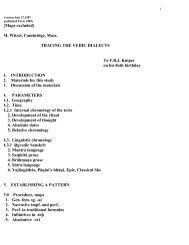The Languages of Harappa - People Fas Harvard
The Languages of Harappa - People Fas Harvard
The Languages of Harappa - People Fas Harvard
Create successful ePaper yourself
Turn your PDF publications into a flip-book with our unique Google optimized e-Paper software.
from two closely related sources languages, e.g. Engl. tea, French thé :: Russian and North<br />
Indian chai, coming from S. and N. China respectively. It is clear that many <strong>of</strong> the following<br />
words go back to such slightly divergent Central Asian origins.<br />
First, it has to be established why we should think <strong>of</strong> central Asian origins. For, in<br />
theory, such loans could also have originated in the Panjab and have traveled to Iran (as is<br />
the case with the words for rice, discussed above), or, conversely, from some Iranian area to<br />
the Panjab. However, a selection <strong>of</strong> the most typical loans tends to center on the Bactria-<br />
Margiana area (cf. Witzel 1995, 1997a n. 54, 1999a,b), perhaps with the inclusion <strong>of</strong> Sistan<br />
for some words. <strong>The</strong> following ones can be plotted both in time and place: *uštr 'camel',<br />
*khar 'donkey', *išt 'brick'.<br />
• *uštr > Ved. ura / Avest. uštra 'camel'. <strong>The</strong> middle and new Akkadian word udru 'Bactrian camel'<br />
is a loan from Iran, see EWA I 238, KEWA III 652, cf. Diakon<strong>of</strong>f in JAOS 105, 1985, 600. <strong>The</strong> domesticated<br />
camel was introduced into the BMAC area from Central Asia only in the late 3rd mill. BCE.<br />
• khar > Ved. khara / Avest. xara 'donkey', cf. also Toch. B ker-ca-po < *karca-bha?, with the<br />
common Indian animal suffix -bha (as seen in garda-bha 'donkey', råsa-bha 'donkey', śara-bha 'a horned<br />
animal', a-bha 'bull'). <strong>The</strong> word may be a late 3rd mill. Near Eastern loan that came to the BMAC area<br />
together with the domesticated donkey, cf. Akkadian (Mari) årum, ajarum 'male donkey', EWA I 447. <strong>The</strong><br />
apparent overlap with Dravidian (denied by EWA 473) in Drav. *garda- > Tamil kalutai 'donkey' is <strong>of</strong><br />
importance as it may represent one <strong>of</strong> the few possible links <strong>of</strong> a Central Asian substrate that is found both in<br />
Dravidian and Vedic.<br />
• *išt > Ved. ii, iikå / Avest. ištiia 'brick', zəmō-ištuua 'clay brick'; OPers. išti, MP., NPers. xišt; cf.<br />
also Toch. iścem 'clay'? <strong>The</strong> regions north <strong>of</strong> the BMAC do not have any bricks in the period before c. 2000<br />
BCE (except, perhaps for the Caucasus area and at Sintashta, east <strong>of</strong> the Urals). Again, the item and the word<br />
would have been encountered by tribes speaking Indo-Iranian or the already separated Old Indo-Aryan<br />
and Old Iranian dialects as soon as they expanded into the one area where these three loans are possible<br />
around c. 2000 BCE (or later): the BMAC area.<br />
<strong>The</strong>se so far neglected words in Indo-Iranian without Indo-European etymologies<br />
(see now Witzel 1999a,b, Lubotsky, forthc.) include, notably, the local words for the newly<br />
introduced domesticated camel and donkey, and for wheat, Ved. godhūma, Avest. gantuma<br />
< *gant-um < gant + um (cf. Berger's reconstruction, Burushaski **γund-um). <strong>The</strong>y are<br />
joined by a number <strong>of</strong> words from agriculture and settled life: *parš 'sheaf', *bīj 'seed,<br />
semen', *ya(u)v(ī)yå 'stream, irrigation channel', *sthūnå 'pillar', *bhiš, bhiš-aj' 'to heal,<br />
healer', *vīnå 'lute', *ling 'mark', *kapaut 'blue', *kadru 'brown'. Of interest are also the<br />
words that have a wider range <strong>of</strong> spread in central Asia and beyond (for details see Witzel<br />
1999a,b): **kana/k'ana 'hemp', *bhang 'hemp', **sinšap 'mustard', *kayap 'tortoise',<br />
**pard/pandh 'spotted animal, panther' (<strong>of</strong>ten found in early and also in later C. Asian art,<br />
see Dani 1992), **kart-ka 'rhinoceros'. <strong>The</strong> last few words which indicate animals that need<br />
a wetter regions than usually found in Central Asia may be connected with the area <strong>of</strong> the<br />
(then well watered) Sistan. (Of still older, E. European or N. Central Asian origin may be:<br />
**medh/melit 'sweet, honey', **sengha/singha 'lion').<br />
Further, there are a number <strong>of</strong> old, little studied local pre-Iranian names. <strong>The</strong>y<br />
include, among others, Avest. Xnəta < *khnanta = Avest. vəhrkåna, Gorgån < *khranta);<br />
Suγδa 'Sogdia', and in O.Pers., the Median Kampanda, Sikaya(h)u-vati; the Arachosian<br />
Aršådå, Gandutava; the Southeast Iranian name Cambyses (Kamb(a)ū/ujiya) ~ Ved.<br />
Kamboja, Karmåna and Maka (modern Makran), Maciya 'a person from Maka' (details in<br />
Witzel 1999a,b).

















